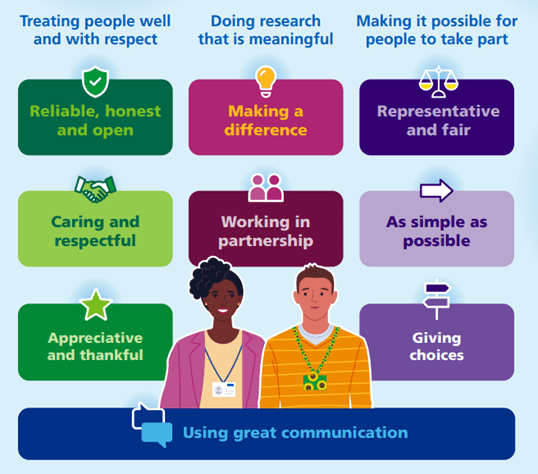As part of a research collaboration with Julie Bayley, the Health Research Authority has launched a new set of Hallmarks for People Centred Clinical Research
Clinical research aims to find out more about an illness, condition, treatment, therapy, or care by directly involving people in a project, and may ask people to take part by testing a new treatment, using a device or by being cared for in a certain way. Whilst many people are included in this kind of research, there are many who have not had the opportunity to do so. The Health Research Authority protects and promotes the interests of patients and the public in health research and as part of a wider Government initiative for change, embarked on a project to explore the barriers to good research practice so everyone can take part in ways that are better for them. The starting point for good people-centred research is researchers asking people “what matters most” and “how can we work together to achieve it?”.
This project involved a range of activities to combine what is already known about people centred research, what people say they need to take part , and an understanding of people’s good and bad experiences of research. Not only was the project about being people-centred, but it was led by people. The steering group comprised of, and was chaired by, public contributors and members of the research community sector. At each stage of the project, this group informed the focus, the materials and the goals, with the group collaboratively shaping all aspects from design to reporting. Julie Bayley (LILI) and Hannah Henderson (Sport and Exercise Science) provided research expertise into this consortium, including designing the plan and methods, designing surveys, reviewing and synthesising literature and leading analysis.
This suite of work identified a series of barriers to true inclusion, and a number of ways meaningful engagement can be made possible. It also identified nine Hallmarks of good people-centred research – under 3 principles – expressing clearly what patients and their representatives feel needs to be in place for them to genuinely participate:

For real change to happen, these changes need embedding into wider research practice, and the HRA will be working with sector partners on integrating this learning across its systems, and in actionable guidance for researchers.
Julie said ‘This is an extremely important initiative. Whilst there is already a considerable body of activity on improving patient involvement in research – not least from patients themselves – true involvement remains challenging. As a patient advocate myself, I’ve seen both amazing practice and sheer tokenism. The Health Research Authority’s decision to embark on this work, and not only involve but hand over the reins of the work to public contributors and research representatives, sends a clear signal to the sector about how significant patient involvement is. We are delighted to have been part of this work, not only as researchers but as part of the collective voice to make it happen. The work highlights the central importance of building trust, making it possible to take part, and feeling it is worthwhile. It also offers a clear picture for researchers about what good people-centred research involves.”
Kate Greenwood, Senior Improvement Delivery Manager, Health Research Authority said “This project is part of a Department of Health and Social Care-led programme to improve clinical research delivery in the UK. The team at the University has been incredible bringing their research expertise, skills and support to the partnership. Crucially their in-depth understanding of behaviour change and real-world impact, combined with an unwavering belief in the patient voice has also meant we were able to work together brilliantly as a group.
The team understood the purpose of this work from the outset, which is to improve clinical research for the people taking part and the difference this should make; from creating more opportunities for people to take part, improving research experience and enhancing research quality and design, to ensuring this research is more likely to make a difference to people. Julie and Hannah really have been fundamental to the shape of this work, and it has been a pleasure to work with them”
A variety of materials have already been produced, including a summary infographic, and a fuller report and paper are currently in preparation. More information about the project is available on the HRA site, and HRA have also produced a number of materials for people to download and use in their work There will also be more to come, so watch this space!